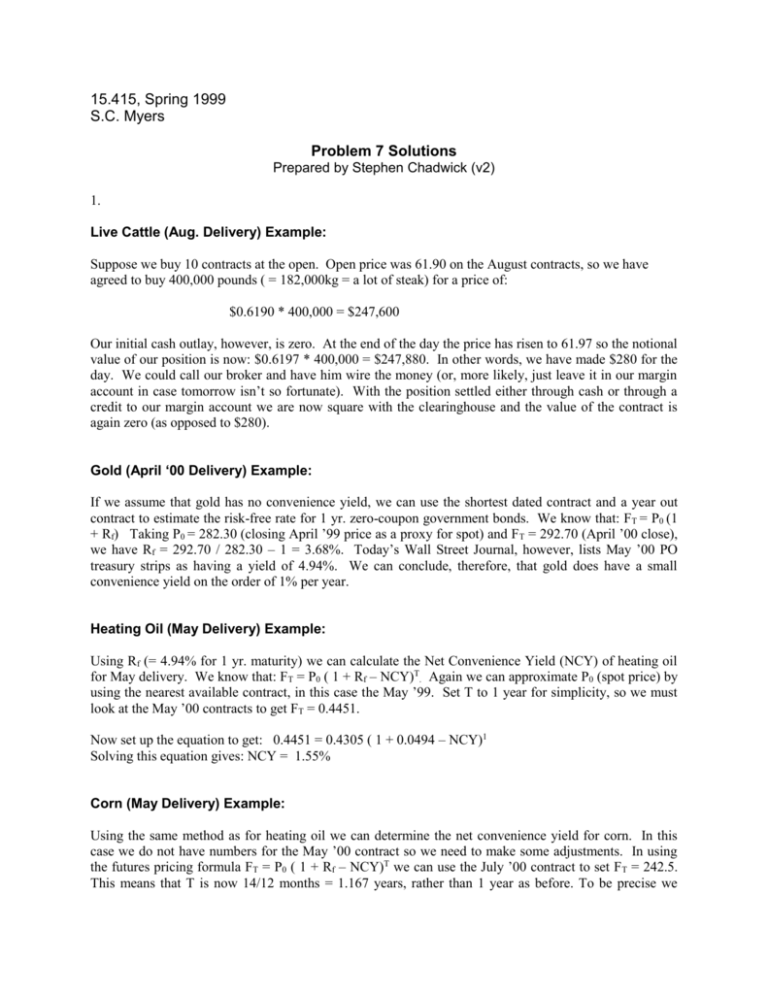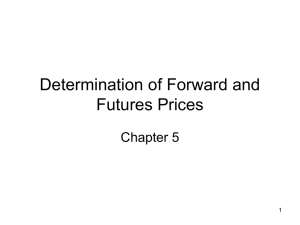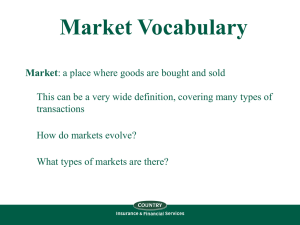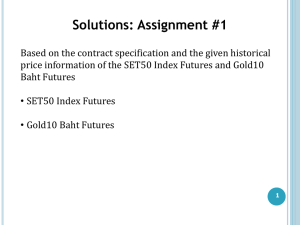Problem Set 7 Solution
advertisement

15.415, Spring 1999 S.C. Myers Problem 7 Solutions Prepared by Stephen Chadwick (v2) 1. Live Cattle (Aug. Delivery) Example: Suppose we buy 10 contracts at the open. Open price was 61.90 on the August contracts, so we have agreed to buy 400,000 pounds ( = 182,000kg = a lot of steak) for a price of: $0.6190 * 400,000 = $247,600 Our initial cash outlay, however, is zero. At the end of the day the price has risen to 61.97 so the notional value of our position is now: $0.6197 * 400,000 = $247,880. In other words, we have made $280 for the day. We could call our broker and have him wire the money (or, more likely, just leave it in our margin account in case tomorrow isn’t so fortunate). With the position settled either through cash or through a credit to our margin account we are now square with the clearinghouse and the value of the contract is again zero (as opposed to $280). Gold (April ‘00 Delivery) Example: If we assume that gold has no convenience yield, we can use the shortest dated contract and a year out contract to estimate the risk-free rate for 1 yr. zero-coupon government bonds. We know that: FT = P0 (1 + Rf) Taking P0 = 282.30 (closing April ’99 price as a proxy for spot) and FT = 292.70 (April ’00 close), we have Rf = 292.70 / 282.30 – 1 = 3.68%. Today’s Wall Street Journal, however, lists May ’00 PO treasury strips as having a yield of 4.94%. We can conclude, therefore, that gold does have a small convenience yield on the order of 1% per year. Heating Oil (May Delivery) Example: Using Rf (= 4.94% for 1 yr. maturity) we can calculate the Net Convenience Yield (NCY) of heating oil for May delivery. We know that: FT = P0 ( 1 + Rf – NCY)T. Again we can approximate P0 (spot price) by using the nearest available contract, in this case the May ’99. Set T to 1 year for simplicity, so we must look at the May ’00 contracts to get FT = 0.4451. Now set up the equation to get: 0.4451 = 0.4305 ( 1 + 0.0494 – NCY)1 Solving this equation gives: NCY = 1.55% Corn (May Delivery) Example: Using the same method as for heating oil we can determine the net convenience yield for corn. In this case we do not have numbers for the May ’00 contract so we need to make some adjustments. In using the futures pricing formula FT = P0 ( 1 + Rf – NCY)T we can use the July ’00 contract to set FT = 242.5. This means that T is now 14/12 months = 1.167 years, rather than 1 year as before. To be precise we should find a new Rf value corresponding to this maturity, but in practice the treasury yield curve is flat enough that we can use Rf = 4.94% as before. Thus we have: 242.5 = 215.25 ( 1 + 0.0494 – NCY )1.167 NCY = -5.8% A negative net convenience yield such as this implies that the storage cost exceeds the benefits of holding the commodity (or at least, the market thinks so.) 2. A. The general calculation is the same for each future: FT = P0 ( 1 + Rf – NCY)T, although in the case of financial futures NCY is replaced by Dividend Yield (DY). For yields that are not specified in terms of a compounded annual figure (e.g. stock dividends) we need to either restate Rf and T, or restate NCY or DY to make sure that all the yields correspond to the right maturity. The Allen Wrench, 5 Yr. T-Note, and Westonian Ruple are examples of this. Magnoosium: F = $2600 * (1 + 0.06 – 0.04)0.5 = $2625.87 Oat Bran: First put monthly NCY into annual terms: NCY = 1.00512 – 1 = 0.062 F = $0.44 * (1 + 0.06 – 0.062 )0.5 = $0.4396 Biotech STX: F = $140.2 * (1 + 0.06)0.5 = $144.34 Allen Wrench Stock: Calculate 6 mo. dividend in % terms: DY = $1.20 / $58 = 2.07% We also need a 6 mo. Rf, which would be 1.060.5 – 1 = 2.95% F = $58 * (1 + 0.0295 – 0.0207) = $58.51 5 Yr. T-Note: 6 mo. DY = 4 / 108.93 = 0.0367 F = $108.93 * (1 + 0.0295 – 0.0367) = $108.15 Westonian Ruple: 6 mo. Ruple Rate = 1.120.5 – 1 = 5.83%. This is the NCY (DY) of holding Ruples. For currency forwards and futures we need to use a slightly different formulation of the price equation (See B&M, pg .718). F = Spot [in A/B] * (Currency A Return / Currency B Return) F = 3.10 * (1.0583 / 1.0295) = 3.1867 Ruples / $ = 0.3138 $ / Ruple B. Since Magnoosium contracts are specified in tons, he would have to sell 1000 contracts for delivery in 6 months. This short position offsets the long position he automatically takes as a producer. C. The Magnoosium company receives a $408 * 1000 = $408,000 payment for gains on its futures position (calculate on your own that at spot P=$2200, F=$2218 with 5 mo. to delivery), which is then marked to market (i.e. revalued at a P=$2200/ton basis). It hasn’t really made money, though, since it takes an equal loss on the value of the Magnoosium it is producing to meet the contract’s delivery requirement. The firm remains perfectly hedged for the 6 mo. delivery date and needs to take no action to maintain the hedge. D. A futures contract on a storable and tradable good can’t give any information about future price movements since doing so would provide arbitrage opportunities. Say the Biotech Index futures prices indicated an expected rise in the next year, but that this was not reflected in the current index price. If you sold the index future short and bought the corresponding basket of stocks at spot you would end up with a certain profit in one year’s time when the prices MUST converge. This argument breaks down if the good is not storable, however, because then the arbitrage can not be used and there is no force to push futures and spot prices into their usual relationship. E. F = $48 * (1 + 0.0295 – 0.0207) = $48.22 With only 6 months to maturity, futures prices and spot prices will tend to move by about the same amount since the interest and convenience yields are relatively small over such a short span. F. We need to determine the spot price of the 5 Yr. T-Note. P= 4 / 1.041/2 + 4 / 1.045 + 4 / 1.0483/2 + 4 / 1.052 + 4 / 1.055/2 + 4 / 1.053 + 4 / 1.057/2 + 4 / 1.054 + 4 / 1.059/2 + 104 / 1.055 = 113.64 6 mo. DY = 4 / 113.64 = 0.0352 And 6 mo. Rf = 1.040.5 – 1= 0.0198 So F = $113.64 * (1 + 0.0198 – 0.0352) = 111.89 The trader would have lost (111.89 – 108.15) * 100 = $374 G. The importer starts out with a short position of 1 million Ruples, which is equivalent to a long position of 1 / 3.10 (R/$) = $322,581. To hedge this he could borrow some amount of dollars today and convert it into Ruples at the spot rate. He would then leave the cash invested in Ruple denominated debt for three months. The amount he would need to borrow today would be the amount that makes the final value of his Ruple account equal the $1m he requires in 3 months. [We assume quarterly compounding here for simplicity.] Strategy: Borrow X dollars at Rf = 6%, so 3 mo. rate is 1.060.25 = 1.467% Convert into 3.10 * X Rubles Invest in Ruple denominated debt for 3 mo. at Rr = 12% or 2.874% / qtr Final value is 1m Ruples, so: 1,000,000 * 1.01467 = 3.10 * X * 1.02874 X = $318,170 Alternatively, he could simply buy 3 mo. Ruple futures with a notional value of 1m Ruples. Assuming there is a 3 mo. contract available, its price should be: F = Spot [in A/B] * (Currency A Return / Currency B Return) F = 3.10 * (1.02874 / 1.01467) = 3.1430 Ruples / $ $1,000,000 / 3.1430 = $318,170 The costs of each strategy are the same, as they must be to avoid arbitrage possibilities. 3. Quiz Question 4, pg. 731 F = (95 – 4) * (1 + 0.049) = 95.459 Quiz Question 7, pg. 731 a. The net convenience yield will increase because it becomes more advantageous to have heating oil when it is cold. This will reduce the futures price relative to spot. b. Now the reverse will occur and futures will become relatively more expensive as the ncy diminishes. Quiz Question 8, pg. 731 Basis risk arises in the case of an imperfect hedging strategy. (A perfect hedge has no basis risk if held to maturity, though it is still possible to lose or gain money if the hedge is abandoned before its time.) There are two usual causes of basis risk: either the item being hedged is not the same as the hedging commodities available (e.g. hedging apple prices with orange futures), or the time periods do not match. In either case the presence of basis risk means that it is possible that at the end of the hedging period the prices of the long and short positions taken in the hedge do not match up, thus causing a loss or a gain on the net position. In this example, A has by far the most basis risk since Disney stock is poorly correlated with the widely traded S&P 500 index future. This is a partial, or imperfect hedge, though it may be better than nothing. The other two examples could be perfect hedges if the time periods match up well, though it is unlikely that the futures markets will be so accommodating. [On the other hand, if the importer in example C is large enough he will have no trouble finding a bank willing to sell him an over-thecounter (OTC) forward contract that matches his needs exactly. Because the global foreign exchange (FX) market is vastly larger than any other market on the planet, the price for such a contracts are very competitive.] Question 1, pg. 732 Legs could hedge his position without incurring a tax liability by selling S&P Index futures short. He would not receive an immediate cash payment and he will not yet have taken a capital gain, even though his market risk will now be zero. This allows him to defer his taxes until the next tax year. During the six months he holds the futures position it will increase or decrease in value as the underlying index fluctuates. While he may occasionally have to make margin payments should the S&P rise significantly, the value of the Vanguard fund he holds should exactly offset this (less the 0.15% Vanguard management fee). The net result is that Legs will have effectively converted his investment in stocks into a bond without having to pay his taxes immediately. Question 10, pg. 733 Assuming no NCY we can put together a risk-free yield curve: F = P0 * (1 + Rf)T Rf = (F / P0)(1/T) – 1 1 mo. annualized Rf = (458.90 / 456.90)12/1 – 1 = 5.38% 3 mo. annualized Rf = (464.50 / 456.90)12/3 – 1 = 6.82% 9 mo. annualized Rf = (483.30 / 456.90)12/9 – 1 = 7.78% 15 mo. annualized Rf = (503.90 / 456.90)12/15 – 1 = 8.14% 21 mo. annualized Rf = (525.70 / 456.90)12/21 – 1 = 8.35% Question 27, pg. 737 a. Since the bank is paying a fixed rate and receiving a floating rate it benefits when rates go up. The initial value of a swap is always set at zero, so it must now be making money on the position. b. The bank should receive the same amount as the price of an opposite swap that would cancel out the arrangement with company A. The question says that the bank could now enter into a contract to pay 6.5% in exchange for libor plus 1%. If the bank were to take the opposite position on this swap it would cancel out its swap with company A while receiving an extra 0.5% in interest each year. The present value of four 0.5% (=$250k on a $50m notional) payments is therefore the fair cost of closing out the swap. P = $250k / 1.065 + $250k / 1.0652 + $250k / 1.0653 + $250k / 1.0654 = $856,450 Question 29, pg. 737 a. A floating rate note is essentially the same as rolling over short-term loans. Since short-term loans tend to be at a lower interest rate than longer term loans (i.e. yield curves usually slope upwards), it makes sense that a fixed loan of 5 years would have a higher rate than a floating note. If discounted at the appropriate risk-free rate for each maturity, the two loans will turn out to have the same positive present value (which, incidentally, exactly represents the credit risk of the firm). b. The swap will involve a floating payment from the bank of 2% above T-bills, in exchange for a fixed payment from Phillips of 9%. If the notional value is set at $20m, this will exactly cancel out the previous arrangement and leave Phillips with just a 9% fixed rate loan. (n.b. An equivalent arrangement would set the rates at T-bills plus zero vs. fixed 7%. The outcome is identical.) c. Since Phillips was able to issue either floating T-bills+2% or fixed 9%, we know that the expected value of the two cash flow streams must be worth the same under the initial yield curve, so there was no required payment when setting up the swap. With T-bills at 6%, the firm will now receive 8% on its swap arrangement. Meanwhile it is paying a fixed 9%. Since the payment terms are quarterly, it will have to make a net payment of 1% / 4 = 0.25% to the swaps dealer. Additionally, it still has the original loan to pay back, which is at a rate of T-bills + 2% = 8%, or 2% quarterly. Its total net quarterly payments will therefore total 2.25%. d. The cost of closing out the swaps agreement would be the present value of the variable stream Phillips is paying, minus the value of the fixed stream it is receiving. Rather than calculating each separately, though, we can use a shortcut. From part C, we know that at current rates the firm must pay 0.25% of the notional amount each quarter. Using this cash flow amount it is simple to find out the net value of the swap by using simple discounting: 0.25% * $20m notional = $50k quarterly payment. Quarterly interest rate is: 6% / 4 = 1.5% PV(Swap) = $50k / 1.015 + $50k / 1.0152 + $50k / 1.0153 + … + $50k / 1.01516 = $706,563 Phillips will have to pay this amount to get out of the deal. To see why it has lost money on the arrangement, consider the two sides of the swap. On the fixed side it has lost money because long rates have fallen by 1%. On the floating side, however, it seems to make up some of this loss as short rates rise—also by 1%. With the notional value equal, why didn’t the two sides cancel out? To understand why, consider the durations of the two parts of the swap. Phillips has effectively shorted a fixed position with a long duration, while it has bought a floating rate note with close to zero duration. Since duration measures the sensitivity of bond value to changes in yield, the long duration position is hit relatively hard by a 1% drop in long term yields. Meanwhile, the floating position would also have lost value for Phillips since short rates actually rose (remember, the rate is only reset every 3 months, so there is a brief period in which a floating rate note can be above or below par). The counterintuitive fact is that Phillips has actually lost value on both sides of the swap! p.s. it seems duration is useful after all…







